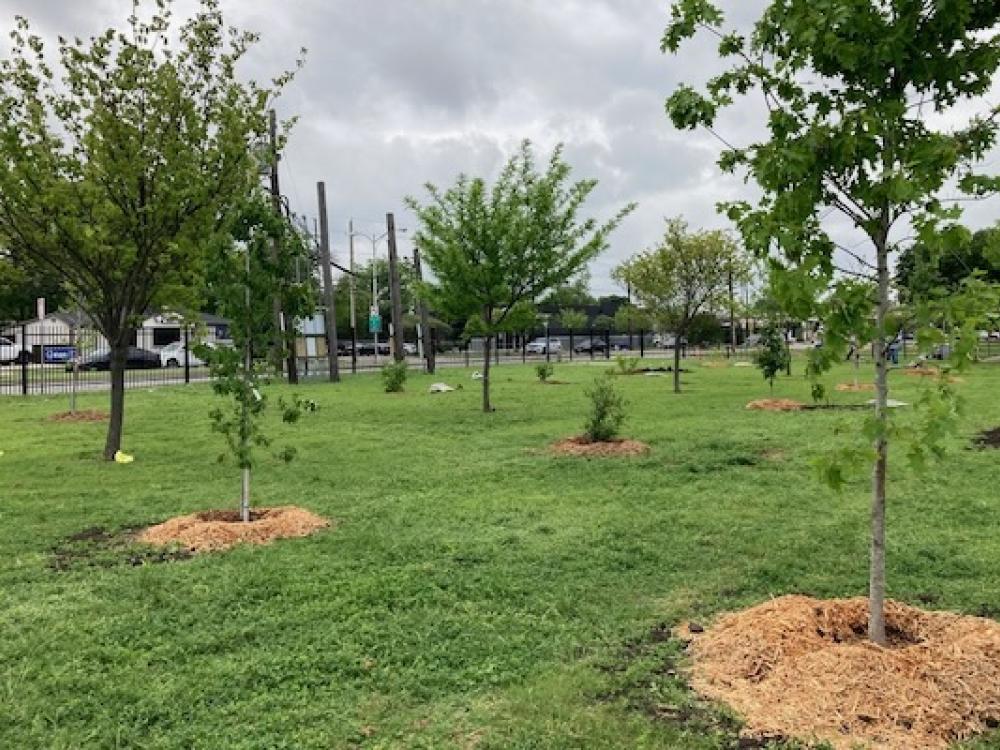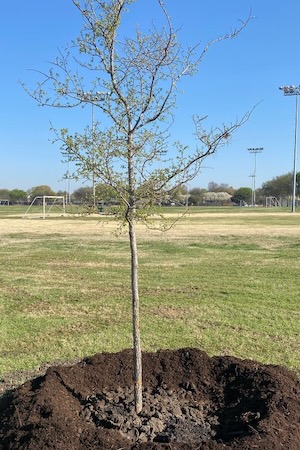
As summer heats up, here are some tips for caring for newly planted trees. Courtesy of Texas Trees Foundation.
June 30, 2023
Summer just officially started last week and we've already experienced stretches of extreme temps.
According to tree experts, older, more established trees are well adapted to the heat and humidity. However, younger and newly planted trees will struggle to thrive under these harsh conditions,
The stress can lead to stunted growth, decay and even death, according to the Texas Trees Foundation, a nonprofit based in Dallas..
Here are two tips from Texas Trees to help your young trees make it through the summer and reach their full potential:
PROPERLY WATER YOUR TREE
Water is important to the basic life functions of a tree, just as it is with us.
Plants generate their own food through photosynthesis, which requires carbon dioxide, sunlight and water.
“Water is necessary for the chemical reactions that create sugars, it’s also necessary to help move the needed materials around in the tree and finally, to utilize those materials,” according to Karl Flocke, Texas A&M Forest Service Woodland Ecologist.
Young or newly planted trees haven’t had time to grow an extensive root system that older trees have. That’s why younger trees need more frequent deep waterings until they become established at roughly two years after planting.
Texas Trees recommends, while temperatures stay above 90 degrees, you should water your tree for two to three minutes every two to three days, ensuring that the area directly around the trunk of the tree gets thoroughly saturated.
Texas A&M Forest Services adds that watering young trees should be focused primarily on and immediately adjacent to the original root ball as these trees have not yet developed long ranging roots.
The amount of water and frequency of watering will vary based on your soil, location and species of tree, so pay close attention as you water it. If there is standing water puddling around the tree that doesn’t drain between watering, consider watering less, letting the pooled water soak in. If the tree is in a shady spot that doesn’t get exposed to direct sunlight all day, the tree may not require as much water as a tree in direct sun all day.
Note that some species of tree require more water while others don’t need much at all. So consult online resources or your local plant nursery to help identify and find the water needs of your tree to create the perfect watering schedule.
MULCH YOUR TREE
Many people don’t mulch or mulch improperly. But experts say mulching a tree is very important step when planting and maintaining a tree.
 A newly planted tree at Campbell Green Park with mulch properly placed around tree. Courtesy of Texas Trees Foundation.
A newly planted tree at Campbell Green Park with mulch properly placed around tree. Courtesy of Texas Trees Foundation.
A layer of mulch, about one to two-inches-thick, should be placed around the tree to the same radius as the tree’s canopy. The edge of the mulch ring should be mounded to form a donut shape around the tree so water will get funneled toward the tree.
This layer of mulch will help retain moisture around the roots of the tree, letting the roots absorb the water that would otherwise be lost through evaporation.
Do not mound the mulch up around the trunk of the tree. Covering the trunk retains too much moister, allowing fungus and bacteria to thrive that lead to rot and decay in the tree as well as providing hiding spaces for insects that could harm the tree.
A mulch bed will also help suppress grass and weeds that would compete with the tree for water and resources. Mulch should be kept away from the trunk and used to cover the soil containing the tree’s roots.
Maintaining a regular water schedule and mulching will help ensure your trees health and happiness over these next hot months and help give it good foundation for the future.
REDUCE STRESS
During times of drought, don’t add additional stresses to your tree, making them more susceptible to secondary problems, such as insect infestation and diseases.
• Don't prune your trees unless absolutely necessary.
“What you’re trying to do is reduce stress to the tree, so pruning, even when you have to, is adding stress because you are wounding the tree,” said Courtney Blevins, Texas A&M Forest Service Urban Forester, based in Fort Worth. “If you’re pruning out live branches or live leaf areas of the tree, you’re removing food and the site where the tree’s root growth hormone is developed, affecting root growth and further stressing the tree at a time where it’s already too stressed.”
According to Blevins, the exception to pruning trees during drought is a completely dead branch or one that is a hazard to its surroundings.
• Skip the fertilzer.
Another common mistake that can be harmful to your trees during a drought is putting out fertilizer.
“Just generally applying fertilizers without knowing if there is a deficiency is a really bad idea,” said Blevins. “If there is not a nutrient deficiency then it’s not going to help anything and it can actually hurt things and make the tree worse.”
TREE WATERING TIPS
• Avoid watering during the heat of the day, when water will evaporate more quickly. Water between 7 p.m. and 8 a.m.
• Water should be applied to the entire area within the dripline under the crown of the tree.
• Texas Trees Foundation also recommends watering outward beyond the dripline if feasible as a mature tree’s roots typically extend farther than the tree’s canopy.
• For all trees, it is important to minimize water contact with the trunk and lower leaves of the tree as water droplets can act as vectors for bacteria and other harmful diseases.
• Follow your local watering ordinance.
RELATED ARTICLES
Trees need watering during Texas drought
'Put water out for wildlife,' urge North Texas rehabbers
Stay up to date on everything green in North Texas, including the latest news and events! Sign up for the weekly Green Source DFW Newsletter! Follow us on Facebook,Twitter and Instagram. Also check out our podcast The Texas Green Report, available on your favorite podcast app.









